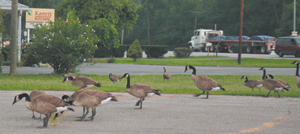WAYNEDALE WOODS & WATERS

Now, some of these birds will also sport larger, plastic bands that are either orange or white, also courtesy of the DFW.
No, the State’s animal experts have not been accessorizing these birds for a night out; these bands allow DNR biologists to better track geese that they have relocated.
The brightly colored new bangles are much larger than the aluminum variety and therefore much more noticeable–gaudy, yet functional.
The select geese with this new “jewelry” have been removed from urban areas after conflicting with humans. Such “urban” geese have been relocated to state Fish and Wildlife Areas (FWAs) by qualified contractors at the expense of the property owner for years, because such lands have better habitat for geese than cities do.
Once on an FWA, geese are less likely to cause problems for people. In addition, these areas allow waterfowl hunting, which helps control the state’s locally breeding goose population. But do such relocations really work in reducing the urban geese problem in the long term?
Many landowners suspect that transplanted geese soon flock right back to their old urban haunts at a very high rate. Previous research has shown that the actual frequency of return varies greatly, from 20 to 80 percent. Conventional wisdom says that geese that are relocated as adults seem to be more likely to return to cities, but those transferred from urban areas before they learn to fly seem to remain at the FWA and breed there; however, the research is not clear-cut.
The birds wearing the bands got them at the FWAs, just before release, enabling property owners, contractors and biologists to watch urban areas to see how many return. They also allow the DFW to better evaluate the success of the relocation method of controlling geese.
Such data can also be used to help address other goose management issues. For instance, if the study shows that few geese return to their original urban area, then it may be that other geese are continually re-colonizing urban ponds. If such is the case, modifying habitat so that geese no longer want to be there may be the only effective way of reducing goose-human conflicts.
This plastic-band study is being done in addition to the DFW’s aluminum banding of more than 2,000 geese in the state each June, which has allowed for the documentation of thousands of reports from hunters and other finders. These data have allowed biologists to understand goose movement better. In addition, the information has allowed for analysis of survival rates, life span and rates at which geese are harvested by hunters.
The old-style bands will still be depended upon to play that role. Each contains a unique number etched on its surface that is registered with the federal Bird Banding Laboratory (BBL) in Patuxent, Md. The BBL coordinates all migratory bird banding in the United States because the federal government has jurisdiction over migratory birds.
When a goose is harvested by a hunter, caught, or found dead, the person who recovers the band gets the ID ball rolling. The finder reports the band number to the BBL, which informs the DFW where and how the band was recovered, and tells the finder where and when the bird was banded.
“Geese banded in Indiana have been harvested in 31 states and Canadian provinces,” said Adam Phelps, waterfowl research biologist with the DFW. “These birds seem to move more than many people think they do. The colored leg bands will help us get better information on those specific birds that are relocated out of these conflict situations.”
Now, persons harvesting birds with the colored leg bands can help with the DFW’s goose research by reporting their find, along with the number on the aluminum leg band, to FWA staff, or to the BBL at 1-800-327-BAND or www.reportband.gov. Live birds with these colored bands need not be reported.
- Community Invited To Paint Rocks For Urban League Project - April 26, 2024
- The “Bad Guys” In Your Garden & What To Do About Them - April 26, 2024
- Why Voting In The Primary Election Matters - April 26, 2024


